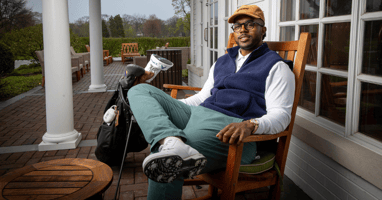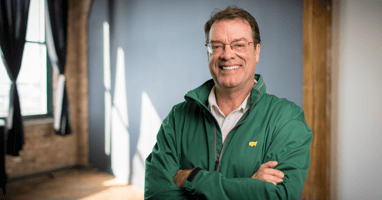CDGA expands its presence, adds second Longest Putt competition and Break the Glass Challenge This...
April 2024 - Mastering Pressure
How watching the pros deal with stress at Augusta can help your own game
This article appeared in the April 2024 edition of Chicago District Golfer.
To read more Chicago District Golfer stories, head to our article archive.

The second week in April means parking in front of the television to watch that “tradition unlike any other,” the Masters. Here’s a suggestion: start another tradition and use your viewing time as a way to improve your game. Don’t just sit there passively, munching on that pimento cheese sandwich. For the observant golfer, the Masters offers a master class in instruction.
We asked three of the area’s top golf professionals about lessons that can be learned by watching the best players navigating Augusta National. The panel features Kevin Weeks, who teaches at Cog Hill; Louis Sauer, the owner of Next Level Golf in Northbrook; and T.J. Sullivan, the Oak Brook-based regional director of instruction for GOLFTEC.
Let the lessons begin:
Strategy
Sullivan notes that the Masters is different than other tournaments because “everyone knows the course so well.”
Indeed, you know about the risk-reward in the par 5s on 13 and 15, and the danger that lurks with the tucked flag against the water on the 11th green. Since you know the course, you can learn from each competitor’s strategy in playing those holes.
The common theme is discipline and playing the percentages.
“The biggest thing for them is that they don't think they have to try to make birdie on every approach shot,” said Sauer, the 2017 Illinois PGA (IPGA) Teacher of the Year.
For instance, almost every player will play it conservatively and aim for the right part of the 11th green.
“A guy I was working with hit it to about four feet on 11,” Weeks said. “We were talking a couple weeks later, and I said ‘Nice shot on 11.’ He said, ‘I pulled it 30 feet."
Weeks added: “They realize there are enough holes out there where the [hole location] is accessible to them. They also know there are holes where you aren’t going to make many birdies. They’re trying to eliminate the bogey and hit their approach to 25 to 30 feet. If they happen to make a long putt, great. If not, they move on.”
The takeaway: Bag the hero shots and play the percentages. A par or bogey is better than an X on the scorecard.
 From left to right: Jouis Sauer, PGA, T.J. Sullivan, PGA, Kevin Weeks, PGA
From left to right: Jouis Sauer, PGA, T.J. Sullivan, PGA, Kevin Weeks, PGA
The Swing
You likely won’t see the best collection of swings in golf at the Masters.
“If you go to the Korn Ferry Tour, you'll see better golf swings and more aesthetically pleasing golf swings than on the PGA Tour,” said Weeks, the 2023 national PGA Teacher & Coach of the Year. “However, on the PGA Tour, they have a better idea of how to make their swings work.”
Indeed, the variety of swings, from Jon Rahm’s short back-swing to Matt Kuchar’s unusually flat swing, all have one thing in common.
“Their delivery to the golf ball are all similar,” said Sullivan, who won the IPGA Player Development award in 2022. “They are coming in with an inside approach to the golf ball with a clubface that is pretty square with some variance. And they are able to repeat it.”
Sullivan added, “The two things that amateurs don't have is a really good awareness of where the clubface is and how to generate speed. That causes them to make compensations in the swing, and problems happen from there. The pros know how to do that. That is why they are where they are.”
The takeaway: Know your swing. Easier said than done.

Putting on Fast Greens
Unless you get to play Augusta National, you probably never will putt on faster or more challenging greens. But you likely will play on some speedy surfaces with big breakers that have three-putts written all over them. Hit a putt too hard, it could roll off the green. Fail to putt it firmly enough and the ball could lose speed and break away from the hole.
Learning how the pros putt at the Masters could save you some shots.
Weeks, one of the top short-game teachers in the country, has a simple tip when you encounter a breaking putt.
“The average player never plays enough break,” Weeks said. “They need to almost double what they think the break is.”
When it comes to speed, Sauer says it is a matter of getting confident by “managing the length of your stroke.”
“You can’t be confident reading a green if you are not confident in getting better control over the speed of your putts,” Sauer said.
On that point, you know that area near the first tee that has a lot of holes in it? You should spend some time there before every round, especially if you are playing fast greens.
“The putting green probably is the place where you will see the least [number] of people on a course,” Weeks said. “Figuring out the green speed is all about practicing on the putting green before the round. If you are trying to do it on the course, you’re in trouble.”
The takeaway: As Weeks said, introduce yourself to the putting green.
Pressure
No, you never will feel the pressure of trying to win a career-defining tournament. But there is pressure everywhere in golf: From CDGA events to club championships to needing to make the 5-footer on 18 to beat your friend.
There is plenty to be learned from watching how the best players handle pressure--or not.
“Look at how a player walks, look at their body language. Are they slumping their shoulders?” Sauer said. “All those things give you a signal where they're at in terms of pressure. The guys who handle pressure the best are the ones who look the same whether or not they are playing well.”
If the pressure builds to uncomfortable levels, Sauer advises you try to slow things down and focus on your breath. It is a way of resetting your brain.
The other essential according to the professionals: When things get tight, the key is staying in the moment. Don’t focus on the last shot; focus only on the next shot.
And be committed to that shot. Sullivan points to Mito Pereira’s errant drive on the 18th hole of the 2022 PGA Championship, which led to a double bogey that cost him the tournament.
“Pereira seemingly had a very different swing on the 18th hole,” Sullivan said. “This comes from trying to be careful, not fully committing to the process of executing the shot.”
Process, process, process. Weeks says that is the most important tool the best players rely on.
“From day one, we focus on the process,” Weeks said. “When you focus on goals and outcomes, you become fearful. When you focus on the process of what you’re trying to do, and not just what happened or what’s going to happen, you become fearless.”
The takeaway: Take it one shot at a time and be fearless, not fearful.
A former golf writer at the Chicago Tribune, Ed Sherman is a frequent contributor to Chicago District Golfer.

.png?height=200&name=Untitled%20design%20(10).png)



